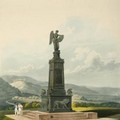Neoclassicism: Technique and Beauty: Pietro Nobile (1776–1854)
West Bohemian Gallery in Plzeň - Exhibition Hall „13“, Pražská 13, Plzeň
November 20, 2019 - February 9, 2020
|
Neoclassicism: Technique and Beauty: Pietro Nobile (1776–1854)West Bohemian Gallery in Plzeň - Exhibition Hall „13“, Pražská 13, PlzeňNovember 20, 2019 - February 9, 2020
This is the first exhibition devoted to this architect, who became the head of the Architecture School at the Academy of Fine Arts in Vienna. Pietro Nobile was an important architect in European Neoclassicism who cannot be easily categorised. He was born in the Italian-speaking canton of Ticino in Switzerland, and became successful at the Viennese court thanks to his commissions from Chancellor Metternich. He was one of the successors to the famous generation of architects led by Claude-Nicolas Ledoux and Étienne-Louis Boullée, whose ideas Nobile began to develop at the Accademia di San Luca in Rome. His interest in the architecture of the “enemy doctrine”, as Nobile referred to his French-influenced training, was eventually overshadowed by the building of a new cultural metropolis in Munich. His visit to Munich in 1835, at Chancellor Metternich’s expense, suggested new possibilities for Neoclassicism and early historicism. Nobile’s approach to Neo-Gothic and Neo-Romanesque architecture, which was then known as the “Byzantine” style, can be seen in his designs for the reconstruction of the Old Town Hall in Prague and the cathedral in Esztergom. The exhibition’s title refers to Nobile’s reformist Architecture School at the Academy of Fine Arts in Vienna between 1818 and 1828. His reform strengthened the Academy’s hand against the Polytechnic, whose students were now obliged to complete their studies at the Academy. The prestige of Nobile’s reform was confirmed by the first exhibition of his architecture students’ work in 1828. His Austrian (Roesner, van der Nül, Siccardsburg, Förster) and Czech (Kranner, Barvitius) students were confirmation of his ability to retain an overview while remaining open to the latest architectural trends at the end of the first half of the 19th century. Nobile’s attention to the aesthetic education of engineers from the Polytechnic showed how he took account of the technical aspects of his structures (bridges, lighthouses). For his buildings in Bohemia Nobile also used mass-produced cast-iron components in utilitarian and religious buildings alike. The exhibition is divided into a number of sections: Nobile and the architecture of the French Revolution; Neoclassicist doctrine and practice (the Hofburg in Vienna, a villa in Rennweg in Vienna, the Horse Gate in Prague and the Church of Sant’Antonio Nuovo in Trieste); Neo-Gothic architecture and early historicism (the Old Town Hall in Prague, the glasshouse in Hietzing and the cathedral in Esztergom), and lastly Nobile’s rivals and students. This is the first exhibition devoted to this architect, who became the head of the Architecture School at the Academy of Fine Arts in Vienna. Archival materials scattered between Vienna, Trieste, Bellinzona, Prague and Kynžvart had previously made it impossible to present a coherent account of this important architect and teacher. The Gallery of West Bohemia offers another new perspective on the history of European architecture, with special reference to the West Bohemia region. |


